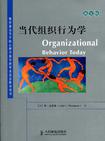当代组织行为学
2009-7
人民邮电出版社
莉·汤普森
279
无
本书由美国西北大学凯洛格商学院莉?汤普森教授撰写,是一本应用广泛、篇幅短小、注重时效性且易于阅读的组织行为学教材。
作者认为组织行为是一个实践性、应用性很强的领域。作为组织中的一员,无论是普通员工还是领导者,都需要学习和掌握组织行为方面的知识。贯穿本书的三个核心特点是:即时性、自我学习和发展、基于理论的实践建议。本书提供的工具可以帮助读者了解自己的长处、评估组织中其他成员的才能,这些技巧可以应用在面试、培训项目、冲突管理以及处理商务问题等诸多方面。
本书可作为我国高等院校心理学、管理学、组织行为学和人力资源管理等学科专业双语教学的教材,也可供广大职场人士和专业研究人员在工作和学习中参考。
Preface xxi
Chapter 1 The Person and the OrganizatiOn
OraanizatiOnaI Life
Defining OrganizatiOnaI BehaviOr
COntentAreas Of OB
Level of Analysis
Guiding Principles Of OB
Skills
Technical Skills
Decision-Making and Judgment Skills
Intetersonal Skills
EthicaI and MOr aI Skills
Seif-Knowledge Skills
Key TensiOns and ChaIIenges for People In organIzations
SeIf versus OrganizationaI Interest
Task Versus People Focus
Work versus Family
Explorat;on versus Exploitation
PromOtion versus PreventiOn
Depth of Knowledge versus Breadth of Knowledge
P0stscript
BuiIding a BOdy of OB Science
MethOds Of OB
Leaminq
You Are a Work in progress
Engage in Double-Loop versus Single-Loop Learning
Bndgelhe Knowing-Doing Gap
Conclusion
Chapter 2 Understanding People and Their Behavior
What Makes PeOple Tick?
Behavior is a Function of Personality and the Situation
Intelligence
G-Factor Intelligence
Multiple Intelligences
Emotional Intelligence
Skill Areas of Emotional Intelligence
Emotions
Measuring EQ
Research Support for EQ
Skills for Building EQ
Temperament and the Big Five
Motivation
Intrinsic versus Extrinsic Motivation
Maslow's Hierarchy of Needs
Expectancy Theory
Goal Setting
Motivations Vis-a-vis Others
Self-Efficacy
Organizational Culture
Organizational Norms
Psychological Contracts
Biases in Understanding Others
Fundamental Attribution Error
Consistency Bias: Halos and Forked Tails
Primacy and Recency Bias
Bandwagon Bias
Roadblocks to Understanding Ourselves
Unrealistic Optimism
Self-Serving Bias/Egocentrism
Omniscience
Omnipotence
The Powerful Process of Adaptation
Conclusion
Chapter 3 Ethics and Values
Ethics and OB
Moments of Truth
Can Ethics Be Taught?
Ethics and Levels of Analysis
Unethical Behavior as Incremental Descents into Wrongdoi
Cognitive Mechanisms
Social-Situational Mechanisms
Ethical Breaches
Prescriptive Ethical Models
Mason, Mason, and Culnan's Six Questions
Badaracco's Four Enduring Questions
Anand, Ashforth, and Joshi's Method for Dealing with
Rationalizatiol
and Socialization of Unethical Behavior
Ethical Rules of Thumb
Front-Page Test
Role Modeling
Third-Party Advice
Policies
Accountability
Conflicts of Interest
Conclusion
Chapter 4 Communication
Basic Communication Model
Sender
Receiver
……
Chapter 5 Power and Influence in Organizations
Chapter 6 Relationships and Social Networks
Chapter 7 Decision Making
Chapter 8 Conflict Management and Negotiation
Chapter 9 Leading and Managing Teams
Chapter 10 Leadership
Chapter 11 Organizational Change
Chapter 12 Fairness and Justice
Chapter 13 Diversity and Culture
Chapter 14 The Virtual Workplace
Glossary
Photo Credits
我理解Leigh L.Thompson教授强调的“当代”有三层含义:第一,就像作者在序言中指出的,该书是关于读者“目前”的教材,读者可以利用书中所描述的方法和工具,直接指导自己目前正在进行的学习和工作。第二,该书在章节结构的安排上虽然承接了传统的组织行为学的基本框架,但在具体内容的取舍上却最大程度地体现了最新的研究结果和组织管理中最热点的问题。尤其是在Thompson教授擅长的组织决策、群体以及谈判等章节,更是资料丰富、论述丰满。第三,比起其他版本,该书的内容非常简洁精练,作者已经将自己理解的组织行为学最精要的部分,以简明扼要的方式呈现给大家。 谢晓非教授 北京大学心理学系

无